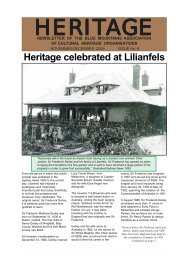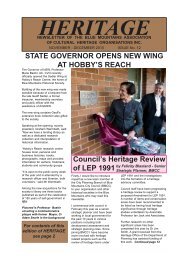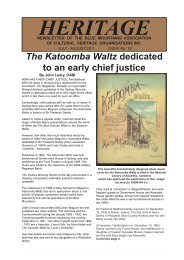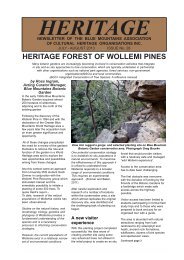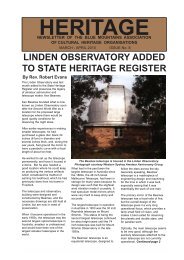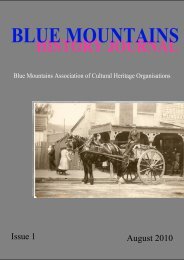Newsletter No. 15 - Blue Mountains Association of Cultural Heritage ...
Newsletter No. 15 - Blue Mountains Association of Cultural Heritage ...
Newsletter No. 15 - Blue Mountains Association of Cultural Heritage ...
You also want an ePaper? Increase the reach of your titles
YUMPU automatically turns print PDFs into web optimized ePapers that Google loves.
<strong>No</strong>rth Springwood’s earliest orchards<br />
thrived with ideal climate, rainfall and soil<br />
<strong>No</strong>rth Springwood had an<br />
advantage over the traditional<br />
farming areas around Sydney<br />
because the climate is tolerable in<br />
summer and winter.<br />
The average rainfall <strong>of</strong> about<br />
125mm falls in autumn and spring<br />
provides ideal growing conditions<br />
for all types <strong>of</strong> produce, particularly<br />
fruit.<br />
The soil derives from an<br />
outcropping <strong>of</strong> Wianamatta Shale<br />
that extends along the crest <strong>of</strong> the<br />
ridge from Springwood to<br />
Winmalee, providing a reasonable<br />
amount <strong>of</strong> fertility but with a harsh<br />
clay sub-soil. Soils around<br />
Hawkesbury Heights and Yellow<br />
Rock tend to be leached sandstone<br />
that is not nearly as rich.<br />
The early explorers first noted<br />
evidence <strong>of</strong> the fertility <strong>of</strong> the area,<br />
and the ‘woods,’ as described by<br />
Blaxland and Macquarie, which<br />
clearly defined the limits <strong>of</strong> the good<br />
soil.<br />
Such evidence is still apparent in<br />
the forests <strong>of</strong> <strong>Blue</strong> Gum Eucalyptus<br />
deanei and Ironbark around the<br />
<strong>Blue</strong> <strong>Mountains</strong> City Council depot<br />
and Buckland Village and in many<br />
places along Hawkesbury Road.<br />
After the first flush <strong>of</strong> expansion<br />
westward from Sydney, following<br />
the crossing <strong>of</strong> the mountains in<br />
1813, development took place in<br />
Springwood with the advent <strong>of</strong> the<br />
railway in 1864.<br />
However, it was not until the late<br />
1880s and early 1890s that viable<br />
farming developed in the <strong>No</strong>rth<br />
Springwood area. In all, about<br />
fifteen farms extended along the<br />
length <strong>of</strong> Hawkesbury Road and at<br />
Yellow Rock.<br />
Initially, the pioneers who took up<br />
land established orchards as a<br />
matter <strong>of</strong> course and most notable<br />
was J.T. Ellison and Honore Marie.<br />
In these early days, everyone who<br />
came as residents <strong>of</strong> the area<br />
established a few fruit trees and a<br />
chook yard to supply the everyday<br />
needs <strong>of</strong> the household.<br />
By Lindsay Paish, Springwood Historians<br />
Grapes being grown on trellises at the Greenheys orchard. Elisha<br />
Wiggins is in the foreground, circa 1880s - 1890s. Photograph courtesy<br />
<strong>Blue</strong> <strong>Mountains</strong> City Council Local Studies Image files.<br />
The larger farms however,<br />
concentrated on earning a living<br />
from the land and the orchardists<br />
developed areas for fruit growing<br />
with great success.<br />
Being virgin country isolated from<br />
the other horticultural areas, they<br />
produced some <strong>of</strong> the finest fruit for<br />
the Sydney market; top quality<br />
disease free apples, stone fruit –<br />
even persimmons – and some <strong>of</strong><br />
the healthiest pr<strong>of</strong>itable citrus<br />
orchards in NSW.<br />
These areas declined however,<br />
after World War 1, because <strong>of</strong> the<br />
growth <strong>of</strong> Batlow and the <strong>No</strong>rth<br />
Coast orchard areas together with<br />
improved transport for the produce.<br />
Passionfruit produced in the area<br />
still held pride <strong>of</strong> place at the<br />
Sydney markets up to the end <strong>of</strong> the<br />
World War 2. The area produced<br />
the finest and earliest fruit for the<br />
market.<br />
Despite the relatively good soils,<br />
there was a need for good<br />
husbandry. It has been recorded<br />
that Ellison successfully treated his<br />
orchard by mulching and enriching<br />
with yearly supplies <strong>of</strong> fresh soil but<br />
no manure.<br />
Similarly, Henry Charles Lennox<br />
Anderson, one-time director <strong>of</strong><br />
NSW Department <strong>of</strong> Agriculture,<br />
studied and experimented with<br />
chemical fertilisers on his White<br />
Cross property.<br />
He concluded that if applied in the<br />
proper manner, chemicals were<br />
productive <strong>of</strong> great and lasting<br />
good, but warned that the land must<br />
be fully tested so that its wants may<br />
be supplied without waste <strong>of</strong><br />
chemicals.<br />
Present day trends however, lean<br />
towards a more conservative<br />
approach away from chemicals<br />
toward a more organic method<br />
similar to what Ellison originally<br />
used.<br />
Many <strong>of</strong> the original properties had<br />
small orchards; Buckland Hospital<br />
provided fresh fruit for its patients<br />
and the tuberculosis hospital,<br />
Lynton Lodge, had a number <strong>of</strong><br />
trees. Cordingley’s farm, ultimately<br />
Bill Morgan’s, had an orchard in<br />
conjunction with his poultry farm.<br />
The White Cross property <strong>of</strong> the<br />
McCredie family (owned later by<br />
Jack Walsh and now the Winmalee<br />
Shopping Centre) also had a fair<br />
sized orchard associated with a<br />
poultry farm. There is little doubt;<br />
most residents in the area grew a<br />
reasonable array <strong>of</strong> fruit trees.<br />
Continued page 19<br />
HERITAGE 18<br />
May - June 2011




